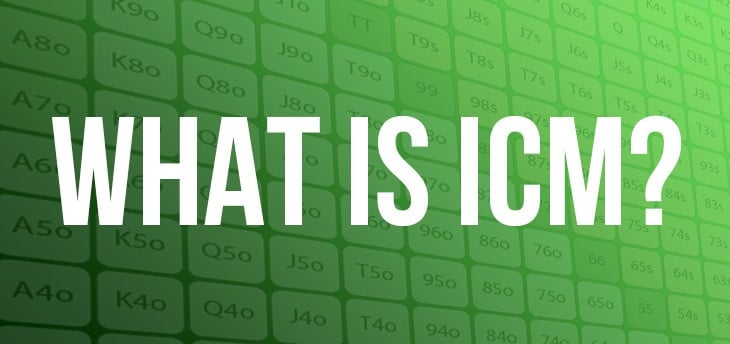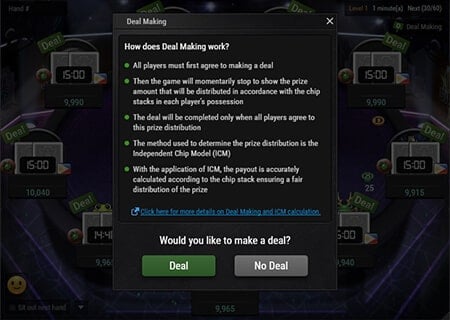Understanding ICM: An Essential Component of Poker Strategy

In your quest to master multi-table tournament (MTT) poker, you’ll encounter a rich tapestry of strategic concepts, with mathematical comprehension being a key thread that ties it all together. To stand tall in the competitive arena of poker and stay a step ahead of your adversaries, you need to keep sharpening your skills, refining your strategy, and making full use of every tool in your poker toolbox. One such vital tool you may have encountered or heard about is the intriguing concept of the “Independent Chip Model” or ICM.
Introduced to the poker world by Mason Malmuth in 1987, the ICM is a mathematical model with a unique purpose: to translate your tournament chip stack into a concrete monetary value. This innovative model uses the size of player stacks to predict the likely finishing position of each player (1st, 2nd, and so forth). Subsequently, it assigns a concept called tournament equity based on the payout structure for those positions. In simpler terms, your tournament equity represents your potential share of the total prize pool. It is calculated based on several factors, including the payout structure, your current standing in the tournament, and the sizes of various stacks.
A profound understanding of the ICM and its implications can assist you in making precise, informed decisions, ultimately leading to a positive expected value over the long haul. Knowledge of the value of your chips at different stages of a tournament is akin to having a secret weapon in your arsenal. For instance, imagine yourself deep in a poker tournament, comfortably sitting on a healthy chip stack as the bubble looms large. Wouldn’t you appreciate the ability to estimate your potential winnings in the long run?

When it comes to poker strategy, questions like these are inevitable: Is it worthwhile risking your healthy stack for a potential double-up right before the bubble? How significant would be the impact on your expected winnings if you were to lose half of your stack? Owing to the specific payout structure of poker tournaments, such questions are often intricate and complex. There are times when survival until the bubble (or the next payout increase) is far more valuable than accumulating more chips. Merely counting your chips rarely provides an accurate evaluation of your tournament situation.
Poker, at its core, is all about maximizing profit through strategic optimization. As the payouts become an integral part of your decision-making process, the environment inevitably changes. This leads to a shift in the optimal strategy for playing No-Limit Hold’em (NLH), where factors such as player position or stack depth can significantly impact strategy. Ignoring these changes in the environment by failing to account for payouts may lead to missed opportunities for boosting your expected value (EV), especially in high-stakes scenarios like deeper tournament stages or final tables.
To further clarify the concept of ICM calculation, let’s walk through an example: Let’s assume three players enter a Sit & Go (SNG) tournament with a $10 buy-in, yielding a total prize pool of $30. The payout structure is straightforward – the winner takes home $20, the runner-up gets $10, and the player finishing last walks away empty-handed. In the opening hand, one player folds, leaving the other two to go all-in. Following the hand, one player is eliminated, leaving just two players remaining. According to ICM, the player with the chip lead, possessing twice as many chips as his opponent, has a 66.7% chance of claiming the remaining $10 of the prize pool. Thus, his stack of 2,000 chips is valued at $16.67, computed by adding the guaranteed $10 for the second place and the 66.7% chance of winning an additional $10 for the first place. The other player’s 1,000 chips, following the same logic, are valued at approximately $13.33.

There’s an important rule of thumb to remember here: the chips you stand to lose in a poker hand are often more valuable than the chips you stand to win. Thus, the ICM helps you craft a strategic game plan based on the value of your stack, rather than simply the chip count, which can often be the difference between a winning and losing approach.
However, as powerful and insightful as the ICM is, it’s important to understand its limitations. The ICM doesn’t account for your personal skill level or edge over your opponents. It also cannot factor in specific table dynamics and interpersonal player behaviors, nor does it evaluate the future value of chips, operating solely on a hand-by-hand basis.
In the final analysis, ICM is a powerful and complex tool designed to convert stack sizes and payouts into actual tournament equity. Although performing these calculations in the heat of the game is virtually impossible, taking the time to study and understand ICM off the table can dramatically improve your performance and potential for success on it.

Just understanding how ICM works will empower you to make critical folds in the later stages of a tournament (or on the bubble). It also provides you with the knowledge to exert pressure on your adversaries by shoving wider and forcing them to fold due to the ICM considerations they have to take into account.
In today’s competitive poker landscape, you need to utilize every weapon at your disposal. The Independent Chip Model is undoubtedly one of the most potent tools available to you and should occupy a central place in your strategic arsenal.
Bear in mind that mastering ICM is not a task you can complete overnight; it requires time, patience, and dedication. However, a strong command of ICM is one of the key differentiators that set good tournament players apart from the very best in the business.
Thank you for taking the time to read this article. Keep the cards flying, the chips stacking, and most importantly, enjoy the game. Good luck at the tables!
-jackpot
